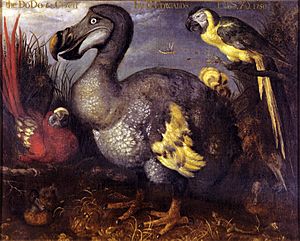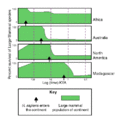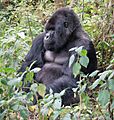Holocene extinction facts for kids

The Holocene extinction is, first of all, the extinction of nearly all large mammal species after the end of the ice age. This is attributed to hunting by humans, and climate change.
Habitat destruction and over-harvesting are two of the primary causes which drive species extinct in more recent times. The fundamental cause of this is the huge increase in human population since the agricultural revolution.
Forests and natural habitats have been greatly reduced throughout the world, and this has been the cause of many extinctions.
Images for kids
-
A diagram showing the ecological processes of coral reefs before and during the Anthropocene
-
The percentage of megafauna on different land masses over time, with the arrival of humans indicated.
-
Top: Arid ice age climate Middle: Atlantic Period, warm and wet Bottom: Potential vegetation in climate now if not for human effects like agriculture.
-
There are roughly 880 mountain gorillas remaining. 60% of primate species face an anthropogenically driven extinction crisis and 75% have declining populations.
-
Angalifu, a male northern white rhinoceros at the San Diego Zoo Safari Park (died December 2014). Sudan, the last male of the subspecies died on March 19, 2018.
-
Bramble Cay melomys were declared extinct in June 2016. This is the first recorded mammalian extinction due to anthropogenic climate change.
-
The golden toad of Costa Rica, extinct since around 1989. Its disappearance has been attributed to a confluence of several factors, including El Niño warming, fungus, habitat loss and the introduction of invasive species.
-
Reconstructed woolly mammoth bone hut, based on finds in Mezhyrich.
-
Genyornis newtoni, a 2-metre (7 ft) tall flightless bird. Evidence of egg cooking in this species is the first evidence of megafaunal hunting by humans in Australia.
-
Recently extinct flightless birds include Madagascar's elephant bird (left), Mauritius's dodo and the great auk of the Atlantic (bottom right).
See also
 In Spanish: Extinción masiva del Holoceno para niños
In Spanish: Extinción masiva del Holoceno para niños












